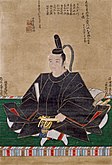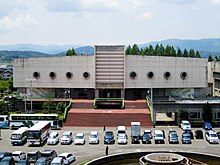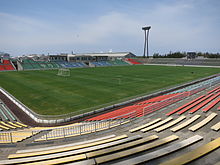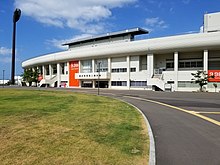world.wikisort.org - Japan
Fukui (福井市, Fukui-shi) is the capital city of Fukui Prefecture, Japan. As of 1 July 2018[update], the city had an estimated population of 264,217, and a population density of 69.2 persons per km2, in 102,935 households.[1] Its total area is 536.41 square kilometres (207.11 sq mi). Most of the population lives in a small central area; the city limits include rural plains, mountainous areas, and suburban sprawl along the Route 8 bypass.
Fukui
福井市 | |||||||||
|---|---|---|---|---|---|---|---|---|---|
Core city | |||||||||
| |||||||||
 Flag  Seal | |||||||||
 | |||||||||
 Location of Fukui in Fukui Prefecture | |||||||||
 Fukui | |||||||||
| Coordinates: 36°3′50.6″N 136°13′10.5″E | |||||||||
| Country | Japan | ||||||||
| Region | Chūbu (Hokuriku) | ||||||||
| Prefecture | Fukui | ||||||||
| Government | |||||||||
| • - Mayor | Shin'ichi Higashimura | ||||||||
| Area | |||||||||
| • Total | 536.41 km2 (207.11 sq mi) | ||||||||
| Population (July 1, 2017) | |||||||||
| • Total | 264,217 | ||||||||
| • Density | 490/km2 (1,300/sq mi) | ||||||||
| Time zone | UTC+9 (Japan Standard Time) | ||||||||
| Phone number | 0776-20-5111 | ||||||||
| Address | 3-10-1 Ōte, Fukui-shi, Fukui-ken 910-8511 | ||||||||
| Climate | Cfa | ||||||||
| Website | www | ||||||||
| Symbols | |||||||||
| Flower | Hydrangea | ||||||||
| Tree | Pine | ||||||||
Overview
Cityscape
- Fukui Station(2018)
- Downtown of FukuiCity(2018)
- FukuiCity Aerial(2014)
- Skyline of FukuiCity(2013)
Geography
Fukui is located in the coastal plain in north-central part of the prefecture. It is bordered by the Sea of Japan to the west and the Ryōhaku Mountains to the east. The Kuzuryū River flows through the city.
Climate
Fukui has a humid subtropical climate (Köppen climate classification Cfa) with hot, humid summers and cool winters. Precipitation is high throughout the year, and is especially heavy in December and January.
| Climate data for Fukui (1991−2020 normals, extremes 1897−present) | |||||||||||||
|---|---|---|---|---|---|---|---|---|---|---|---|---|---|
| Month | Jan | Feb | Mar | Apr | May | Jun | Jul | Aug | Sep | Oct | Nov | Dec | Year |
| Record high °C (°F) | 19.9 (67.8) |
21.8 (71.2) |
26.2 (79.2) |
32.0 (89.6) |
34.5 (94.1) |
36.4 (97.5) |
38.6 (101.5) |
38.5 (101.3) |
37.7 (99.9) |
32.3 (90.1) |
27.5 (81.5) |
24.6 (76.3) |
38.6 (101.5) |
| Average high °C (°F) | 6.7 (44.1) |
7.8 (46.0) |
12.2 (54.0) |
18.3 (64.9) |
23.3 (73.9) |
26.5 (79.7) |
30.4 (86.7) |
32.2 (90.0) |
27.7 (81.9) |
22.1 (71.8) |
16.0 (60.8) |
9.8 (49.6) |
19.4 (66.9) |
| Daily mean °C (°F) | 3.2 (37.8) |
3.7 (38.7) |
7.2 (45.0) |
12.8 (55.0) |
18.1 (64.6) |
22.0 (71.6) |
26.1 (79.0) |
27.4 (81.3) |
23.1 (73.6) |
17.1 (62.8) |
11.3 (52.3) |
5.9 (42.6) |
14.8 (58.6) |
| Average low °C (°F) | 0.5 (32.9) |
0.3 (32.5) |
2.8 (37.0) |
7.8 (46.0) |
13.4 (56.1) |
18.2 (64.8) |
22.7 (72.9) |
23.7 (74.7) |
19.4 (66.9) |
13.1 (55.6) |
7.3 (45.1) |
2.7 (36.9) |
11.0 (51.8) |
| Record low °C (°F) | −15.1 (4.8) |
−14.3 (6.3) |
−9.9 (14.2) |
−2.6 (27.3) |
1.3 (34.3) |
7.3 (45.1) |
12.8 (55.0) |
13.4 (56.1) |
7.7 (45.9) |
0.5 (32.9) |
−1.5 (29.3) |
−11.2 (11.8) |
−15.1 (4.8) |
| Average precipitation mm (inches) | 284.9 (11.22) |
167.7 (6.60) |
160.7 (6.33) |
137.2 (5.40) |
139.1 (5.48) |
152.8 (6.02) |
239.8 (9.44) |
150.7 (5.93) |
212.9 (8.38) |
153.8 (6.06) |
196.1 (7.72) |
304.0 (11.97) |
2,299.6 (90.54) |
| Average snowfall cm (inches) | 85 (33) |
58 (23) |
14 (5.5) |
0 (0) |
0 (0) |
0 (0) |
0 (0) |
0 (0) |
0 (0) |
0 (0) |
0 (0) |
31 (12) |
186 (73) |
| Average precipitation days (≥ 0.5 mm) | 24.3 | 20.0 | 17.4 | 13.3 | 12.0 | 11.9 | 13.5 | 9.9 | 12.4 | 13.4 | 17.5 | 23.5 | 189.2 |
| Average relative humidity (%) | 82 | 78 | 71 | 68 | 68 | 74 | 76 | 73 | 76 | 76 | 78 | 81 | 75 |
| Mean monthly sunshine hours | 65.4 | 88.4 | 136.3 | 172.3 | 191.1 | 146.8 | 155.4 | 205.7 | 151.2 | 154.4 | 114.4 | 72.2 | 1,653.7 |
| Source: Japan Meteorological Agency[2] | |||||||||||||
| Climate data for Koshino, Fukui City (1991−2020 normals, extremes 1978−present) | |||||||||||||
|---|---|---|---|---|---|---|---|---|---|---|---|---|---|
| Month | Jan | Feb | Mar | Apr | May | Jun | Jul | Aug | Sep | Oct | Nov | Dec | Year |
| Record high °C (°F) | 19.8 (67.6) |
21.4 (70.5) |
24.4 (75.9) |
30.5 (86.9) |
33.6 (92.5) |
34.7 (94.5) |
38.2 (100.8) |
37.6 (99.7) |
36.6 (97.9) |
31.1 (88.0) |
26.1 (79.0) |
22.9 (73.2) |
38.2 (100.8) |
| Average high °C (°F) | 8.1 (46.6) |
8.5 (47.3) |
11.9 (53.4) |
17.2 (63.0) |
22.0 (71.6) |
25.0 (77.0) |
29.3 (84.7) |
30.9 (87.6) |
26.8 (80.2) |
21.5 (70.7) |
16.4 (61.5) |
11.1 (52.0) |
19.1 (66.3) |
| Daily mean °C (°F) | 5.5 (41.9) |
5.5 (41.9) |
8.2 (46.8) |
13.1 (55.6) |
17.8 (64.0) |
21.3 (70.3) |
25.7 (78.3) |
27.2 (81.0) |
23.4 (74.1) |
18.3 (64.9) |
13.3 (55.9) |
8.2 (46.8) |
15.6 (60.1) |
| Average low °C (°F) | 2.9 (37.2) |
2.7 (36.9) |
4.8 (40.6) |
9.2 (48.6) |
14.0 (57.2) |
18.3 (64.9) |
22.8 (73.0) |
24.3 (75.7) |
20.6 (69.1) |
15.6 (60.1) |
10.4 (50.7) |
5.5 (41.9) |
12.6 (54.7) |
| Record low °C (°F) | −3.8 (25.2) |
−4.7 (23.5) |
−1.2 (29.8) |
0.6 (33.1) |
6.9 (44.4) |
10.1 (50.2) |
16.2 (61.2) |
17.6 (63.7) |
13.6 (56.5) |
6.9 (44.4) |
1.5 (34.7) |
−1.3 (29.7) |
−4.7 (23.5) |
| Average precipitation mm (inches) | 218.4 (8.60) |
139.8 (5.50) |
156.6 (6.17) |
143.0 (5.63) |
157.6 (6.20) |
157.8 (6.21) |
225.7 (8.89) |
146.7 (5.78) |
230.2 (9.06) |
166.1 (6.54) |
173.6 (6.83) |
253.8 (9.99) |
2,169.4 (85.41) |
| Average precipitation days (≥ 1.0 mm) | 23.6 | 18.3 | 15.5 | 12.0 | 11.3 | 11.3 | 12.4 | 8.7 | 11.8 | 11.8 | 15.7 | 23.0 | 175.4 |
| Mean monthly sunshine hours | 46.2 | 72.7 | 132.9 | 176.3 | 194.2 | 145.9 | 163.9 | 215.4 | 150.4 | 138.8 | 96.7 | 53.8 | 1,587.3 |
| Source: Japan Meteorological Agency[3][4] | |||||||||||||
Neighbouring municipalities
Demographics
Per Japanese census data, the population of Fukui has remained relatively steady over the past 40 years.
| Year | Pop. | ±% |
|---|---|---|
| 1873 | 39,784 | — |
| 1970 | 231,901 | +482.9% |
| 1980 | 259,638 | +12.0% |
| 1990 | 270,911 | +4.3% |
| 2000 | 269,557 | −0.5% |
| 2010 | 266,796 | −1.0% |
| 2020 | 262,328 | −1.7% |
| Source: Fukui population statistics, Japanese Imperial Commission (1873) | ||
History
This section needs expansion. You can help by adding to it. (July 2018) |
Origins
Fukui was part of ancient Echizen Province.
Sengoku Period
In 1471, Asakura had displaced the Shiba clan as the shugo military commander of Echizen Province.[5] The same year, Asakura Toshikage (1428–1481) fortified the Ichijōdani by constructing hilltop fortifications on the surrounding mountains and constructing walls and gates to seal off the northern and southern end of the valley. Within this area, he contracted a fortified mansion, surrounded by the homes of his relatives and retainers, and eventually by the residences of merchants and artisans, and Buddhist temples. He offered refuge to people of culture or skills from Kyoto attempting to escape the conflict of the Ōnin War, and the Ichijōdani became a major cultural, military, and population center, and by the time of Asakura Takakage (1493–1548) it had a peak population of over 10,000 inhabitants. Yoshikage succeeded his father as head of the Asakura clan and castle lord of Ichijōdani Castle in 1548.[6][7]
The Asakura maintained good relations with the Ashikaga shogunate, and thus eventually came into conflict with Oda Nobunaga. Following Nobunaga's capture of Kyoto, Shōgun Ashikaga Yoshiaki appointed Asakura Yoshikage as regent and requested aid in driving Nobunaga out of the capital.[8] As a result, Nobunaga launched an invasion of Echizen Province. Due to Yoshikage's lack of military skill, Nobunaga's forces were successful at the Siege of Kanegasaki and subsequent Battle of Anegawa in 1570, leaving the entire Asakura Domain open to invasion.[5][9][10]
Ichijōdani was razed to the ground by Nobunaga during the 1573 Siege of Ichijōdani Castle.[11]
Kitanosho Castle is known, though that it was built by Shibata Katsuie in 1575. Also, it appears that the tenshu (keep) was nine stories high, making it the largest of the time.
- Asakura Yoshikage
- Ichijōdani Asakura Family Historic Ruins
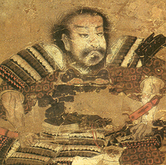 Shibata Katsuie
Shibata Katsuie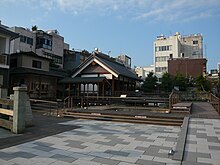 Kitanosho Castle(Sibata Jinja)
Kitanosho Castle(Sibata Jinja)
Edo Period
Castle town and centre of Fukui Domain during the Edo period Tokugawa shogunate. Fukui Domain played a key role in the Meiji restoration. The modern city of Fukui was founded with the creation of the modern municipalities system on April 1, 1889.
- Yūki Hideyasu
- Fukui Castle
Meiji, Taisho & Showa Period
During the pre-war period, Fukui grew to become an important industrial and railroad centre. Factories in the area produced aircraft parts, electrical equipment, machine motors, various metal products and textiles.
Fukui was largely destroyed on June 19, 1945 during the Bombing of Fukui during World War II. Of the city's 1.9 sq mi (4.9 km2) at the time, 84.8% of Fukui was destroyed, per the United States Army Air Forces's Strategic Bombing Survey.
- Fukui District Court
- Fukui City Water Service Memorial
- Fukui Prefectural Office Building (1923)
Modern Fukui
Fukui was again devastated by a major earthquake in 1948.
On February 1, 2006, the town of Miyama (from Asuwa District), the town of Shimizu, and the village of Koshino (both from Nyū District) were merged into Fukui.
Fukui's city status was designated a core city on April 1, 2019.[12]
Government
Fukui has a mayor-council form of government with a directly elected mayor and a unicameral city legislature of 32 members. The city also contributes 12 members to the Fukui Prefectural Assembly. In terms of national politics, Fukui forms part of Fukui 1st district, a single-member constituency of the House of Representatives in the national Diet of Japan.
External relations

Twin towns – sister cities
International
Fukui is twinned with:[13]
- Sister Cities
| City | Country | State | since |
|---|---|---|---|
| New Brunswick | New Jersey | May, 1982 | |
| Fullerton | California | November, 1989 |
- Friendship Cities
| City | Country | State | since |
|---|---|---|---|
| Hangzhou | Zhejiang | November, 1989 | |
| Suwon | Gyeonggi | April, 2001 |
National
- Sister Cities
| City | Prefecture | region | since |
|---|---|---|---|
| Kumamoto | Kyūshū region | November, 1994 |
- Friendship cities
| City | Prefecture | region | since |
|---|---|---|---|
| Yūki | Kantō region | April, 2002 |
- Partnership cities
| City | Prefecture | region | since |
|---|---|---|---|
| Nagano | Chūbu region | August 9, 2013 |
Economy


The economy of Fukui is mixed. The city is a regional commercial and finance centre; however, manufacturing, agriculture and commercial fishing also are contributors to the local economy.
Primary sector of the economy
Agriculture
- Japan Agricultural Cooperatives(JA)
- Fukui Prefecture Agricultural Cooperatives(JA FukuiPrefecture)
Fishing industry
- Japan Fisheries cooperative(JF)
- FukuiCity Fisheries cooperative(JF FukuiCity)
Secondary sector of industry
Manufacturing industry
Fukui is home to several companies, including:
- Matsuura Machinery, an international heavy machinery manufacturing company[14]
- Morinaga Hokuriku Dairy, a dairy products subsidiary of Morinaga Milk Industry
- Kumagai Gumi, a large general construction company, was founded and has its registered head office in the city.[15]
Tertiary sector of industry
Service industry
- Emori Shoji, a trading house with strong ties to China
- Keifuku Bus
Education

Universities and colleges
- Fukui Prefectural University
- University of Fukui
- Fukui University of Technology
- Jin-ai Women's College
- Fukui College of Health Sciences
Secondary schools
- Fujishima Senior High School
- Koshi Senior High School
- Fukui Commercial Senior High School
- Usui Senior High School
- Asuwa Senior High School
- Michimori Senior High School
- Kagaku-Gijutsu Senior High School
- Fukui Norin Senior High School
- Hokuriku Senior High School
- Fukui University of Technology - Fukui Senior High School
- Jin-ai Girl's Senior High School
- Keishin Senior High School
- Fukui Minami Senior High School
Other schools
- Fukui Prefectural School for the Blind
- Fukui Prefectural School for the Deaf
- A North Korean school: Hokuriku Korean Elementary and Junior High School (北陸朝鮮初中級学校).[16]
Transport



(Hokuriku Expressway)

Railways
High-speed rail
 West Japan Railway Company (JR West)
West Japan Railway Company (JR West)
- Hokuriku Shinkansen: (under construction)
Conventional lines
 West Japan Railway Company (JR West)
West Japan Railway Company (JR West)
- Hokuriku Main Line:Echizen-Hanandō - (Minami-Fukui Freight Terminal) - Fukui - Morita
- Etsumi-Hoku Line (Kuzuryū Line):Echizen-Hanandō - Rokujō - Asuwa - Echizen-Tōgō - Ichijōdani - Echizen-Takada - Ichinami - Kowashōzu - Miyama - Echizen-Yakushi - Echizen-Ōmiya - Hakariishi
 Fukui Railway
Fukui Railway
- Fukubu Line:Sanjūhassha - Taichō no Sato - Asōzu - Harmony Hall - Seimei - Ebata - Bell-mae - Hanandō - Sekijūjimae - Shokokaigisho-mae - Asuwayama-Koenguchi - Fukui Castle Ruins-daimyomachi - Jin'ai Joshikōkō - Tawaramachi
- Mikuni Awara: Fukui - Shin-Fukui - Fukuiguchi - Matsumoto Machiya - Nishi-Betsuin - Tawaramachi - Fukudaimae-Nishi-Fukui - Nikkakagaku-Mae - Yatsushima - Nittazuka - Nakatsuno - Jin'ai Ground-Mae - Washizuka-Haribara
- Katsuyama Eiheiji Line: Fukui - Shin-Fukui - Fukuiguchi - Echizen-Kaihotsu - Echizen-Shinbo - Oiwakeguchi - Higashi-Fujishima - Echizen-Shimabashi
Roads
Expressways
 Hokuriku Expressway
Hokuriku Expressway
Japan National Route
 National Route 8
National Route 8 National Route 158
National Route 158 National Route 305
National Route 305 National Route 364
National Route 364 National Route 416
National Route 416
Seaways
Sea Port
- Port of Takasu
Visitor attractions

- Ichijōdani Asakura Family Historic Ruins, one of the most important cultural heritage sites in Japan
- Yōkōkan Garden
- Fukui Castle
- Fukui Fine Arts Museum
- Kitanosho Castle
- Asuwa River
- Harmony Hall Fukui
- Fukui International Activities Plaza
- "Yoroppaken", creator of Fukui's trademark dish, sauce katsudon (ソースカツ丼)
- Peace Pagoda, the second of its kind in the world, inaugurated in 1959
- Yōkōkan Garden
- The Yōkōkan Kantei
- Fukui Castle
- Fukui District Court
- Fukui International Activities Plaza
- Harmony Hall Fukui
- Koshino beach
Culture
Sports
Baseball
- Fukui Wild Raptors(BC.League)
Handball
- Hokuriku Electric Power Company Blue Thunder(JHL)
Soccer
- Fukui United FC(Hokushinetsu Football League)
- Fukui Phoenix Stadium
- Fukui Prefectural Gymnasium
- Fukui Prefectural sports Park(9.98 Stadium)
- Fukui Velodrome
References
- Official home page
- 気象庁 / 平年値(年・月ごとの値). Japan Meteorological Agency. Retrieved May 19, 2021.
- 観測史上1~10位の値(年間を通じての値). JMA. Retrieved April 2, 2022.
- 気象庁 / 平年値(年・月ごとの値). JMA. Retrieved April 2, 2022.
- "Asakura Yoshikage". Encyclopedia of Japan. Tokyo: Shogakukan. 2012. OCLC 56431036. Archived from the original on 2007-08-25. Retrieved 2012-08-22.
- "朝倉 義景" [Asakura Yoshikage]. Nihon Jinmei Daijiten (日本人名大辞典) (in Japanese). Tokyo: Shogakukan. 2012. Archived from the original on 2007-08-25. Retrieved 2012-08-22.
- "朝倉 義景" [Asakura Yoshikage]. Nihon Kokugo Daijiten (in Japanese). Tokyo: Shogakukan. 2012. OCLC 56431036. Archived from the original on 2007-08-25. Retrieved 2012-08-22.
- "朝倉 義景" [Asakura Yoshikage]. Kokushi Daijiten (in Japanese). Tokyo: Shogakukan. 2012. OCLC 683276033. Archived from the original on 2007-08-25. Retrieved 2012-08-22.
- "朝倉義景" [Asakura Yoshikage]. Dijitaru Daijisen (in Japanese). Tokyo: Shogakukan. 2012. OCLC 56431036. Archived from the original on 2007-08-25. Retrieved 2012-08-22.
- Turnbull, Stephen (1987). Battles of the Samurai. Arms and Armour Press. p. 60. ISBN 978-0853688266.
- "Ichijodani Asakura Family Site Museum". Retrieved 2017-10-10.
- "平成31年4月 中核市『福井市』誕生!". Official website of Fukui. April 1, 2019. Retrieved April 7, 2019.
- "市政情報". city.fukui.lg.jp (in Japanese). Fukui. Retrieved 2020-04-11.
- "Company Profile". Matsuura Machinery. Retrieved on May 7, 2019.
- "Corporate Profile Archived 2017-12-09 at the Wayback Machine." Kumagai Gumi. Retrieved on August 31, 2017."
- "Archived copy". www.hks35.ac.jp. Archived from the original on 21 November 2003. Retrieved 11 January 2022.
{{cite web}}: CS1 maint: archived copy as title (link)
External links
- Official website (in Japanese)
 Geographic data related to Fukui (city) at OpenStreetMap
Geographic data related to Fukui (city) at OpenStreetMap
На других языках
[de] Fukui
Fukui (japanisch 福井市, -shi) ist eine Stadt innerhalb der Region Chūbu in Japan, nördlich des größten Sees des Landes, des Biwa-See gelegen. Sie ist die größte Stadt sowie zugleich Verwaltungssitz der Präfektur Fukui.- [en] Fukui (city)
[es] Fukui (Fukui)
La ciudad de Fukui (福井市, Fukui-shi?) es la capital de la prefectura de Fukui. Se encuentra localizada en la parte norte de la prefectura, en la costa del mar de Japón en la región de Chubu/Hokuriku.[ru] Фукуи (город)
Фукуи́[1][2] (яп. 福井市 Фукуи-си) — особый город и административный центр префектуры Фукуи в Японии. Площадь города составляет 536,19 км²[3], население — 264 801 человек (1 июля 2014)[4], плотность населения — 493,86 чел./км².Другой контент может иметь иную лицензию. Перед использованием материалов сайта WikiSort.org внимательно изучите правила лицензирования конкретных элементов наполнения сайта.
WikiSort.org - проект по пересортировке и дополнению контента Википедии















